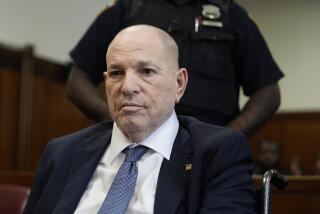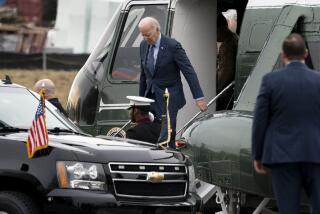Cheney May Get Implant to Help Heart
- Share via
WASHINGTON — Following recent episodes of an irregular heartbeat, Vice President Dick Cheney said Friday he will enter the hospital today for tests that likely will require the immediate implantation of a pacemaker device as an “insurance policy” against further abnormal heart rhythms.
He said he expects to return home shortly after the procedures, even if they result in the implant of a cardioverter defibrillator, a battery-powered device that corrects irregular heart rhythms.
“And I’d expect to be back at work on Monday if everything goes as planned,” Cheney said Friday in the White House briefing room, where he described his medical status.
Cheney’s physician said the vice president’s abnormally fast heartbeat detected two weeks ago does not indicate a progression of his coronary heart disease. Still, the vice president’s latest medical setback renewed concerns about his continuing ability to perform his duties.
Cheney, 60, suffered his first heart attack in 1978, then a second in 1984. After his third in 1988, he underwent quadruple bypass surgery. And since November’s election, he has been hospitalized twice, first for a mild heart attack and then for heart-related surgery.
As he has in the past, the vice president dismissed questions Friday about his fitness to serve.
“No, I have no long-term doubts. The doctors have assured me there’s no reason why either the procedure or the device that’s being implanted should in any way inhibit my ability to function as the vice president,” he said.
But, he added: “If it were the doctors’ judgment that any of these developments constituted the kind of information that indicated I would not be able to perform, I’d be the first to step down. I don’t have any interest in continuing in the post unless I’m able to perform adequately.”
Ari Fleischer, the White House press secretary, also brushed aside concerns about Cheney’s capacity to do his job.
“Many of these same questions came up after the last time the vice president had a medical procedure, and he was right back at his desk working. And that has been the case in each one of these instances,” Fleischer said.
Cheney’s most recent heart attack occurred Nov. 22, during the recount of the presidential campaign’s disputed outcome in Florida. At the time, physicians and Bush-Cheney campaign officials initially released little information, causing then-Texas Gov. George W. Bush to erroneously declare that Cheney had not had a heart attack.
Given that experience, Cheney told reporters Friday, “I thought it was important to come down [to the briefing room] because there obviously is great interest, for understandable reasons, in the health of the vice president. And we’ve had enough experience now that sometimes misinformation does arise.”
Doctors treated Cheney’s November heart attack by inserting a stent to prop open an almost completely blocked artery. In March, Cheney underwent angioplasty to clear the artery. In angioplasty, a tiny balloon is threaded up through a blood vessel and into a coronary artery, then inflated to squash the blockage and stretch the artery open, restoring normal blood flow.
Cheney informed President Bush on Tuesday of his latest medical condition and said Bush “encouraged me to go forward and do the procedure.” Fleischer said Cheney made his final decision Thursday night to proceed. Reporters were notified by e-mail only 15 minutes before Cheney appeared in the briefing room.
In his discussion with Bush, Cheney said there was no talk of resignation.
As for his running on the GOP ticket again in 2004, Cheney said, “That’s something that [Bush] hasn’t asked me about and I haven’t talked to him about. . . . But that’ll be his call, and if I am in shape to do it and if my health permits, then I’d be perfectly happy to serve.”
Cheney’s history of heart disease has loomed as an issue for Bush ever since he named Cheney as his running mate in July. Cheney, who had headed the effort to screen vice presidential prospects, was a surprise pick. Bush said he selected him because Cheney’s service as White House chief of staff for President Ford and as Defense secretary for Bush’s father made him eminently qualified to assume the presidency if necessary.
As was expected, Cheney has proved an unusually influential vice president, serving as a top foreign policy advisor, the administration’s chief congressional lobbyist and chairman of the White House energy task force.
Cheney is to undergo tests and the likely implant of a cardioverter defibrillator at George Washington University Medical Center, just a few blocks from the White House.
“I think the odds are fairly small that we would go do the test and not do the implant,” Cheney said.
About the same time, Bush is scheduled to meet at Camp David in Maryland with visiting Japanese Prime Minister Junichiro Koizumi.
According to Dr. Jonathan Samuel Reiner, the vice president’s cardiologist, Cheney will first undergo an electrophysiology to assess his risk of developing a persistent abnormal heartbeat.
Physicians prescribed this procedure after Cheney experienced four “brief, asymptomatic episodes of abnormally fast heartbeats,” Reiner said.
Those irregularities were detected during a 34-hour period two weekends ago while Cheney wore a portable electrocardiogram. The vice president said he never felt an abnormal heartbeat.
“I’m oblivious to these incidents when they occur, and they only last one or two seconds,” he said. “It’s just a short period of time when there’s a rapid heartbeat, and then it stops.”
Explaining his decision to wear the electrocardiogram, Cheney said, “In somebody with my history, it’s good preventive medicine.”
There had been no sense of urgency in doing so, he said. Indeed, Cheney postponed wearing the monitor for several weeks--until he had a free weekend at home. Cheney said he also wore such a monitor about eight to 10 years ago.
The procedure today requires passing wires into the heart through the veins accessible at the top of a leg, according to Reiner.
Cheney described the procedure’s risk as “minimal,” adding: “This is a procedure I’ve had done numerous times in the past. . . . They insert a couple of small, fine wires up into the heart and then run some tests, and based on that, then make the decision about going forward with the implant.”
Physicians will use a local anesthetic and mildly sedate the vice president intravenously during the procedure. “You do not go under a general anesthetic,” Cheney told reporters.
Should the defibrillator prove necessary, as expected, doctors would implant it on the spot.
Reiner said the device--officially known as an implantable cardioverter defibrillator--is “roughly the size of a small pager, weighing less than 80 grams.” It would be implanted under the skin of the upper chest.
Cheney described the ICD as “about 2 inches by 2 inches and about half an inch thick.”
“The ICD’s main function is to interrupt rapid heart rhythms,” Reiner said. “If the ICD detects an arrhythmia, it can terminate the abnormal rhythm with either a pacemaker function or the delivery of a low-energy electrical shock.”
About 100,000 such implant procedures are performed each year, Cheney said. The device’s batteries last five to eight years.
Cheney will leave Thursday as scheduled for his home in Wyoming for some fishing and horseback riding, a spokeswoman said.
Since he became vice president, Cheney has changed his diet, and he exercises several days a week for as long as 30 minutes each time. He has lost an estimated 25 pounds over the last several months.
*
MORE INSIDE
Surgery: Putting ‘an emergency room’ in Cheney’s chest. A12
More to Read
Get the L.A. Times Politics newsletter
Deeply reported insights into legislation, politics and policy from Sacramento, Washington and beyond. In your inbox twice per week.
You may occasionally receive promotional content from the Los Angeles Times.










